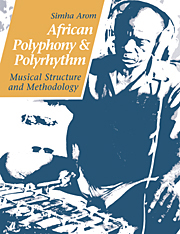Book contents
- Frontmatter
- Contents
- List of illustrations
- Foreword by György Ligeti
- Preface
- Acknowledgements
- BOOK I THE MUSIC OF THE CENTRAL AFRICAN REPUBLIC
- BOOK II AFRICAN POLYPHONIC MUSIC
- BOOK III TECHNICAL TOOLS: METHODS OF RECORDING POLYPHONIC MUSIC FOR TRANSCRIPTION
- BOOK IV THEORETICAL TOOLS
- BOOK V THE ORGANISATION OF TIME IN AFRICAN MUSIC
- BOOK VI STRUCTURAL PRINCIPLES AND THEIR APPLICATION
- 1 Typology
- 2 Analytical notions
- 3 Strict polyrhythmics
- 4 Polyrhythmics as a way to polyphony: Hocket
- 5 Polyphony produced by melodic instruments
- 6 The association of polyphony and polyrhythmics
- Conclusion
- Bibliography
2 - Analytical notions
Published online by Cambridge University Press: 27 January 2010
- Frontmatter
- Contents
- List of illustrations
- Foreword by György Ligeti
- Preface
- Acknowledgements
- BOOK I THE MUSIC OF THE CENTRAL AFRICAN REPUBLIC
- BOOK II AFRICAN POLYPHONIC MUSIC
- BOOK III TECHNICAL TOOLS: METHODS OF RECORDING POLYPHONIC MUSIC FOR TRANSCRIPTION
- BOOK IV THEORETICAL TOOLS
- BOOK V THE ORGANISATION OF TIME IN AFRICAN MUSIC
- BOOK VI STRUCTURAL PRINCIPLES AND THEIR APPLICATION
- 1 Typology
- 2 Analytical notions
- 3 Strict polyrhythmics
- 4 Polyrhythmics as a way to polyphony: Hocket
- 5 Polyphony produced by melodic instruments
- 6 The association of polyphony and polyrhythmics
- Conclusion
- Bibliography
Summary
The analysis of any cultural phenomenon is reductive by definition. This follows from the fact that, in the terms of Gilles-Gaston Granger (1967:2), ‘any attempt to understand any facet of man must start with a reduction of our experience to a set of correlative marks’. On this principle, if we want an adequate description of how Central African polyphonies operate as systems, we must find a suitable set of correlative marks, and say why we consider them to be basic. A further need will be to examine the various facets and levels in our data where we find these marks at work.
The first step in our analysis will be to reduce this music to writing by transcription. This involves a set of preliminary operations enabling pitch (degrees on a scale) to be discriminated, and temporal organisation (metrics and rhythmics) to be grasped. It will therefore also be necessary to give a principled explanation of the scores appearing in the remainder of this volume.
The main purpose of the present chapter is to provide an explicit statement, and in so doing to justify the choice, of the criteria we apply to the analysis of Central African types of polyphony and polyrhythmics. Two important questions must, however, be dealt with beforehand. The first concerns all types of Central African music, while the second relates only to music of the polyphonic type.
Can the term mode be applied to the arrangement of strictly pentatonic melodic material?
Can the notion of harmony be applied to the vertical structures engendered by this same material?
The importance of the answers we provide to these questions for our choice of analytical criteria and our results is immediately evident.
- Type
- Chapter
- Information
- African Polyphony and PolyrhythmMusical Structure and Methodology, pp. 218 - 228Publisher: Cambridge University PressPrint publication year: 1991



